SEOUL, South Korea (AP) ā Swarms of ālovebugsā are back in South Korea, blanketing a mountain peak, entering houses and sticking to car windows.
Flying attached to one another while mating, the , known to scientists as Plecia nearctica, are also called united bugs, double-headed bugs or honeymoon flies.
Lovebugs were first detected in large numbers in northwestern in 2022. Now, hordes of lovebugs appear throughout the city and some nearby areas, mainly between late June and early July each year.
The insects do not transmit diseases or sting humans, but there have been increasing public complaints about lovebugs sticking to car windows and the walls of houses, restaurants and subway trains.
Clouds of lovebugs recently hovered over the peak of Gyeyang Mountain in Incheon city, just west of Seoul. The lovebugs swarmed observation decks as workers constantly shoveled dead insects from the ground, according to videos shown on local TV stations.
āCompared with the past two years, the number of lovebugs sharply surged last weekend at the mountain,ā Gyeyang district official Wang Hyeon-jeong said Tuesday.
The 395-meter (1,295-feet) mountain has likely provided the type of hot, humid weather conditions in which lovebugs thrive, the Environment Ministry said, possibly leading to the insect population surge.
In Seoul and other areas, it is not yet clear whether there have been more lovebugs than in previous years. The ministry said it will review the seriousness of this year's case after the insects disappear, likely by mid-July.
South Korean officials view lovebugs as beneficial insects, saying they help pollinate flowers as their larvae convert plant materials into organic components. They said they avoid chemical pesticides when coping with the large insect population, instead spraying them with water and using stick pads.
Many experts say the flow of lovebugs to South Korea, likely from China, is associated with the country's warming temperature and is linked to .
Hyung-jin Kim, The Associated Press



